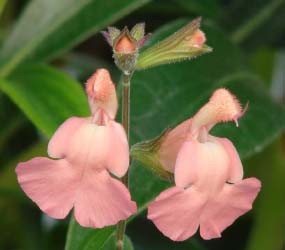Salvia x jamensis: Painting the Landscape with Pastels

Planning a flowerbed with pastel bicolored Jame Sage (Salvia x jamensis)is a bit like organizing a fancy sweet 16 birthday party. It takes finesse and the right guest list of complementary perennials and annuals for fun and harmony. These Salvias generally are colorful, but not boisterous.
Most Salvia’s, including S. x jamensis, prefer full sun and well-drained soil that is on the dry side. So their partners need to be drought-resistant as well as being the right heights and hues.
Lively Plant Parents
However, Jame Sages aren’t as prim as their pastels might indicate. They originate from a hybrid swarm created by crossings between two mostly bright-colored species of Mexican Salvias – Autumn Sage (S. greggii) and Mountain Sage (S. microphylla).
Botanical explorers discovered the swarm in 1991 in Central Mexico where the Autumn and Mountain sages meet at the juncture of the western and eastern Sierra Madre mountains. S. greggii comes from the western-mountain side of the family; S. microphylla from the east.
Similar to Autumn Sage, S. x jamensis varieties have small, smooth leaves, love full sun and are shorter than Mountain Sage. However, as with Mountain Sage, they can tolerate a bit more shade and moisture than Autumn Sage and generally don’t flower as much as Mountain Sage in the summer months. Instead their blossoms mostly appear in spring and again in fall until frost.
But enough of genealogy. Let’s get this garden party going and paint the landscape pastel with an occasional brighter color. Following are two ideas for groupings of walkway or foundation plantings based on some favorite Jame Sages at Flowers by the Sea.
Bella, Buttercup and Rosy Amid Full Moon
For a luminous gathering of pale pink and cream Jame Sages, we suggest these choices for U.S. Department of Agriculture Plant Hardiness Zones 7 to 9:
- Elk Bella Rosa Jame Sage (Salvia x 'Elk Bella Rosa') -- Pink with a touch of burgundy
- Elk Buttercup Jame Sage (Salvia x 'Elk Buttercup') -- Pale butter-yellow with a hint of pink
- Elk Twilight's Rosy Glow (Salvia x 'Elk Twilight's Rosy Glow') -- Salmon pink
- Full Moon Hybrid Jame Sage (Salvia x jamensis 'Full Moon') -- Creamy yellow and rose pink bicolor.
None of these plants grows more than 36 inches tall, so they are ideal for edging situations such as walkways, driveways and foundations.
A Peachy Creamy Party with Lavender Too
S. x jamensis is well known for its creamy sunset colors including lavenders, oranges, rusty pinks and yellows . Following are three of these pale beauties, along with a taller, rosy orange, spring-to-fall blooming Autumn Sage. All are fine for Zones 7 to 9. Here’s the list of invitees:
- Elk Lush Lavender Jame Sage (S. x 'Elk Lush Lavender') -- Pale lavender with white throats
- Caviar Hybrid Jame Sage (S. x jamensis 'Caviar') -- Salmon pink
- Yellow Pink Hybrid Jame Sage (S. x jamensis ‘Yellow Pink’) -- Dusty pink with pale yellow throat
- Lowrey's Peach Autumn Sage (S. greggii ‘Lowrey's Peach’) -- Rosy orange with a hint of yellow.
Arrangements and Questions
The participants and seating -- excuse us, planting -- arrangements for both of these floral parties ultimately are up to you. But please, pretty please, contact us if you have questions about any of our plants or want to share information and/or photos about your garden party.

 Salvia greggii 'Orange Yucca Do'
Salvia greggii 'Orange Yucca Do'  Salvia x jamensis 'Yellow Pink'
Salvia x jamensis 'Yellow Pink'
Comments
There are no comments yet.